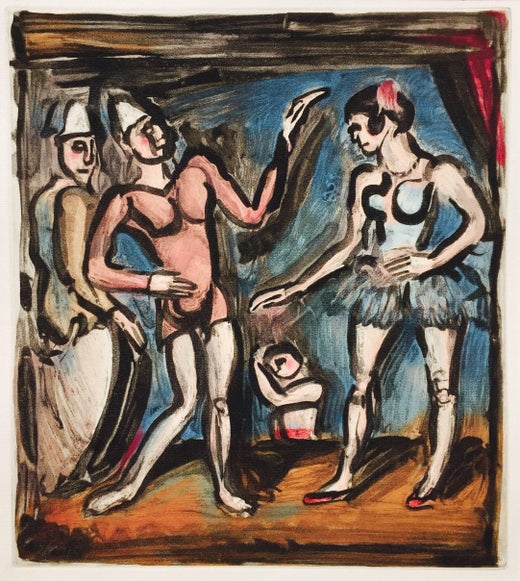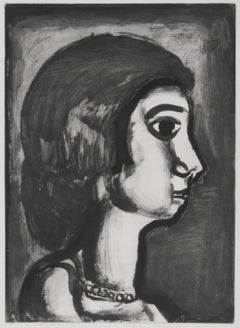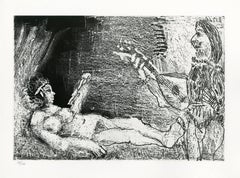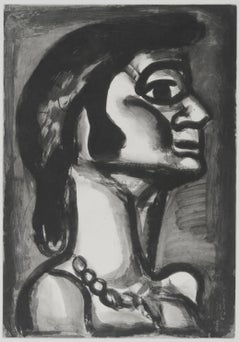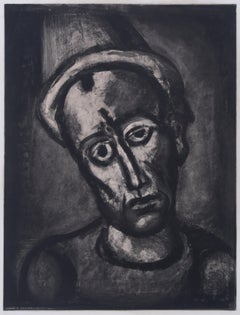Want more images or videos?
Request additional images or videos from the seller
1 of 11
Georges RouaultNe sommes-nous pas forçats? (Are we not Slaves?)1926
1926
Price:$1,000
$1,800List Price
About the Item
- Creator:Georges Rouault (1871-1958, French)
- Creation Year:1926
- Dimensions:Height: 23.25 in (59.06 cm)Width: 17.25 in (43.82 cm)
- Medium:
- Movement & Style:
- Period:
- Condition:
- Gallery Location:Fairlawn, OH
- Reference Number:Seller: FA69961stDibs: LU14015849402
Georges Rouault
Executed in 1937, Carlotta belongs to a group of portraits of members of society. Unlike Picasso and Toulouse-Lautrec, who portrayed these individuals with pathos, Rouault’s approach was unapologetic and raw. In the present work several layers of pigment can be discerned; the build-up of translucent and opaque layers of paint creates a three-dimensionality that characterizes the artist’s strongest work. Furthermore, the work is highlighted by the deep swaths of black delineating the subject, representing a signature element of Rouault’s portraiture of this period.
About the Seller
5.0
Recognized Seller
These prestigious sellers are industry leaders and represent the highest echelon for item quality and design.
Gold Seller
Premium sellers maintaining a 4.3+ rating and 24-hour response times
Established in 1978
1stDibs seller since 2013
827 sales on 1stDibs
Associations
International Fine Print Dealers Association
Authenticity Guarantee
In the unlikely event there’s an issue with an item’s authenticity, contact us within 1 year for a full refund. DetailsMoney-Back Guarantee
If your item is not as described, is damaged in transit, or does not arrive, contact us within 7 days for a full refund. Details24-Hour Cancellation
You have a 24-hour grace period in which to reconsider your purchase, with no questions asked.Vetted Professional Sellers
Our world-class sellers must adhere to strict standards for service and quality, maintaining the integrity of our listings.Price-Match Guarantee
If you find that a seller listed the same item for a lower price elsewhere, we’ll match it.Trusted Global Delivery
Our best-in-class carrier network provides specialized shipping options worldwide, including custom delivery.You May Also Like
Les Vieux (The Elders)
By Félix Hilaire Buhot
Located in Middletown, NY
A lovely, dark impression with excellent provenance.
Paris: Lemerre, 1880.
Etching, drypoint, aquatint (dust ground and spirit ground), spit bite, and roulette in black on cream laid paper with a deckle edge, 6 3/4 x 4 1/2 inches (170 x 112 mm), full margins. Fourth state (of 5). An illustration from Alphonse Daudet's, Lettres de mon moulin, Paris, 1880. In very good condition with some light uniform toning and two areas of paper tape at the top right and left corners on the verso (from a former mount). With the 1921 J.H. de Bois circular ink stamp in green ink in the lower right margin on the recto (Lugt L.733).
[Bourcard 113].
A note regarding the provenance:
J. H. de Bois was a well known late-19th century modern art...
Category
1880s French School Interior Prints
Materials
Etching, Drypoint, Aquatint
Le Curé de Cucignan
By Félix Hilaire Buhot
Located in Middletown, NY
A lovely, dark impression with excellent provenance.
Paris: Lemerre, 1880.
Etching, drypoint, aquatint (dust ground and spirit ground), spit bite, and roulette in black on cream laid paper with a deckle edge, 6 3/4 x 4 1/2 inches (170 x 112 mm), full margins. Third state (of 4). An illustration from Alphonse Daudet's, Lettres de mon moulin, Paris, 1880. In very good condition with some light uniform toning and two areas of paper tape at the top right and left corners on the verso (from a former mount). With the 1921 J.H. de Bois circular ink stamp in green ink in the lower right margin on the recto (Lugt L.733).
[Bourcard 112]
A note regarding the provenance:
J. H. de Bois was a well known late-19th century modern art...
Category
1880s French School Interior Prints
Materials
Drypoint, Etching, Aquatint, Laid Paper
Pommiers à Auvers
By Charles François Daubigny
Located in Middletown, NY
New York: Dodd, Mead, 1884.
Etching with aquatint on cream laid paper, 7 3/4 x 10 3/4 inches (196 x 272 mm), full margins. Light age tone, some very minor cockeling and a 1.5 inch v...
Category
Late 19th Century French School Landscape Prints
Materials
Laid Paper, Engraving, Aquatint
Jeanne
By Armand Rassenfosse
Located in Middletown, NY
Leipzig: Zeitschrift für Bildende Kunst, 1904
Etching with aquatint printed in brownish black ink on cream laid paper, 9 3/8 x 7 inches (237 x 176 mm), full margins. In good conditio...
Category
Late 19th Century French School Portrait Prints
Materials
Laid Paper, Etching, Aquatint
La diligence de Beaucaire
By Félix Hilaire Buhot
Located in Middletown, NY
Paris: Lemerre, 1880.
Etching, drypoint, aquatint (dust ground and spirit ground), spit bite, and roulette in black on cream laid paper with a deckle edge, 6 3/4 x 4 1/2 inches (170 x 112 mm), full margins. Third state (of 3). An illustration from Alphonse Daudet's, Lettres de mon moulin, Paris, 1880. In very good condition with some light uniform toning and two areas of paper tape at the top right and left corners on the verso (from a former mount). With the 1921 J.H. de Bois circular ink stamp in green ink in the lower right margin on the recto (Lugt L.733).
[Bourcard 110].
A note regarding the provenance:
J. H. de Bois was a well known late-19th century modern art...
Category
1880s French School Interior Prints
Materials
Laid Paper, Drypoint, Etching, Aquatint
Femme a l'Estampe
By Manuel Robbe
Located in Middletown, NY
Edition of 100.
Color aquatint and etching, 21 x 14 7/8 inches (531 x 376 mm), wide margins (full). Signed in pencil, lower left image area. Light toning, otherwise in very good cond...
Category
Early 20th Century French School Portrait Prints
Materials
Etching, Aquatint
Les Quartier des Gobelins
By Auguste Lepère
Located in Middletown, NY
Paris: Gazette des Beaux Arts, 1896. Etching with aquatint on cream laid paper, 7 7/8 x 4 7/8 (200 x 125 mm), full margins. Edition of roughly 750. In good condition with uniform ton...
Category
Late 19th Century French School Landscape Prints
Materials
Laid Paper, Etching, Aquatint
Portrait de Fanny Charrin /// Female Women Artist French Impressionist Modern
Located in Saint Augustine, FL
Artist: Nori Malo-Renault (French, 1871-1953)
Title: "Portrait de Fanny Charrin"
Portfolio: Gazette des Beaux-Arts
*Issued unsigned
Year: 1909
Medium: Original Etching and Drypoint o...
Category
Early 1900s French School Figurative Prints
Materials
Drypoint, Etching, Intaglio
Matinée Avenue de Clichy
By Auguste Brouet
Located in Middletown, NY
Drypoint etching on buff wove paper, 9 1/2 x 10 3/4 inches (240 x 271 mm) full margins. Signed in the image, lower left. With the "Musée Louvre Chalcographie" blind stamp in the lowe...
Category
Early 20th Century French School Landscape Prints
Materials
Handmade Paper, Drypoint, Etching
En Provence; la Maison d'Orléans (Valognes)
By Félix Hilaire Buhot
Located in Middletown, NY
Etching in brownish black ink on cream laid paper, 5 3/8 x 3 1/2 inches (135 x 87 mm), partially trimmed lower sheet edge. With the artist's moniker in ...
Category
1840s French School Landscape Prints
Materials
Handmade Paper, Etching
More From This Seller
View AllFille dite de joie (They Call Her Daughter of Joy)
By Georges Rouault
Located in Fairlawn, OH
Fille dite de joie (They Call Her Daughter of Joy)
Aquatint, drypoint, roulette and burnishing over heliogravure, 1922-1927
Unsigned (as issued)
From: Miserere (Have Mercy), 58 plate...
Category
1920s French School Figurative Prints
Materials
Aquatint
Plate X, Le Cocu Magnifique
By Pablo Picasso
Located in Fairlawn, OH
Plate X, Le Cocu Magnifique
Etching & aquatint, 1968
Unsigned
Edition: From the unsigned edition of 200 impressions printed on Rives BFK paper
There is also a signed edition of 30 im...
Category
1960s French School Figurative Prints
Materials
Etching, Aquatint
En bouche qui fut fraîche, goût de fiel (In the mouth that was once fresh, ...
By Georges Rouault
Located in Fairlawn, OH
En bouche qui fut fraîche, goût de fiel (In the mouth that was once fresh, the taste of bitterness)
Aquatint, drypoint, roulette and burnishing over heliogravure, 1922
Unsigned as ...
Category
1920s French School Figurative Prints
Materials
Aquatint
Qui ne se grime pas? (Who does not wear a mask?)
By Georges Rouault
Located in Fairlawn, OH
Qui ne se grime pas?
(Who does not wear a mask?)
Aquatint, roulette, drypoint, acid bite, and scorper, 1923
Signed in the plate loweer left (see photo)
Dated in pencil
Series: Miser...
Category
1920s French School Figurative Prints
Materials
Aquatint
Madame Carmencita, Plate 9
By Georges Rouault
Located in Fairlawn, OH
Madame Carmencita, Plate 9
From: Cirque de l'etoile filante (Circus of the Shooting Star), 1934-1936 (published 1938)
Signed with the artist's initials and dated, lower right of plat...
Category
1930s French School Figurative Prints
Materials
Aquatint
Loin du sourire de Reims (Far from the Smile of Rheims)
By Georges Rouault
Located in Fairlawn, OH
Loin du sourire de Reims (Far from the Smile of Rheims)
Aquatint, drypoint, roulette and burnishing over heliogravure, 1922
Signed with the initials in the plate and dated (see photo...
Category
1920s French School Figurative Prints
Materials
Aquatint
Recently Viewed
View AllMore Ways To Browse
Stations Of The Cross
Antique Cathedral Glass
Picasso Dejeuner
Picasso Gravure
Picasso King
Picasso Letter
Picasso Lithograph Horses
Picasso Non Vouloir
Picasso Picador Et Taureau
Picasso Satyr
Pierre Bonnard Signed
Pkz Posters
Rare Vintage Original Skate Decks
Rembrandt Etching Amsterdam
Renoir Hand Signed
Roger Jourdain
Rouault Passion
Roy Lichtenstein Composition
